Get free scan and check if your device is infected.
Remove it nowTo use full-featured product, you have to purchase a license for Combo Cleaner. Seven days free trial available. Combo Cleaner is owned and operated by RCS LT, the parent company of PCRisk.com.
What is booking.com?
booking.com helps people to find hotels, flights, car rentals, and other similar travel-related services. This site is legitimate, but criminals generate revenue by promoting booking.com affiliate links via fake Adobe Flash Player updaters.
The same tools are also used to distribute various potentially unwanted applications (PUAs) that cause unwanted redirects, deliver intrusive advertisements, gather sensitive information, and promote in-app purchases.
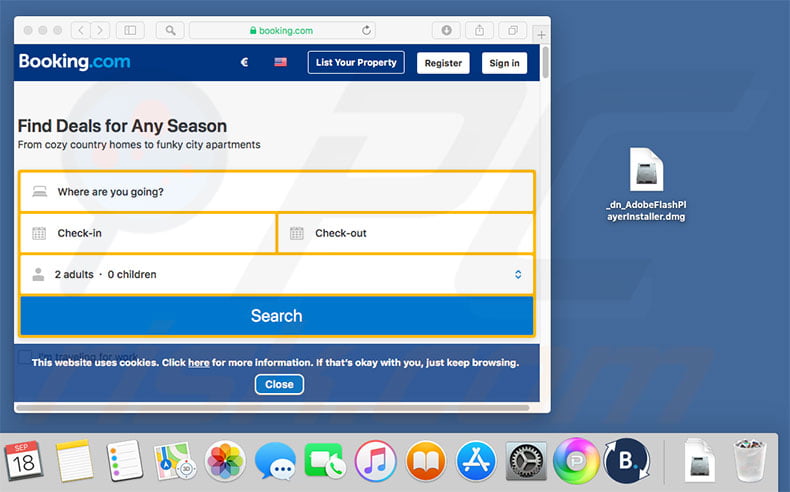
Fake Adobe Flash Player updaters add a booking.com website shortcut to the Mac Dock. The shortcut itself is harmless - once clicked, it simply opens the browser and redirects users to booking.com, however, it indicates the presence of unwanted applications.
Therefore, if the booking.com website icon has been created and added to the Dock without your consent, there is a high probability that your computer is infected with adware, browser hijackers, or other potentially unwanted apps.
Adware-type applications often deliver intrusive advertisements that conceal underlying website content and redirect to other malicious sites and execute scripts that download and install other PUAs (or even high-risk malware).
Browser hijackers modify browser options (usually homepage, default search engine, and new tab URL) so that users continually encounter unwanted redirects. Adware and browser hijackers are also likely to track browsing activity. Some potentially unwanted applications are legitimate, but they infiltrate systems without users' permission.
In any case, if you have noticed booking.com website's shortcut, uninstall all dubious applications/browser add-ons and scan the system with Combo Cleaner anti-virus suite to remove all remnants.
| Name | booking.com redirect |
| Threat Type | Mac malware, Mac virus |
| Symptoms | Your Mac became slower than normal, you see unwanted pop-up ads, you get redirected to shady websites. |
| Distribution methods | Deceptive pop-up ads, free software installers (bundling), fake flash player installers, torrent file downloads. |
| Damage | Internet browsing tracking (potential privacy issues), displaying of unwanted ads, redirects to shady websites, loss of private information. |
| Malware Removal (Windows) |
To eliminate possible malware infections, scan your computer with legitimate antivirus software. Our security researchers recommend using Combo Cleaner. Download Combo CleanerTo use full-featured product, you have to purchase a license for Combo Cleaner. 7 days free trial available. Combo Cleaner is owned and operated by RCS LT, the parent company of PCRisk.com. |
There are dozens of potentially unwanted applications, all of which are virtually identical. By offering "useful features", they attempt to give the impression of legitimacy, but these apps are designed only to generate revenue for the developers. Few provide the functions promised - most are useless.
Rather than enabling any useful functionality, these applications deliver intrusive ads, cause unwanted redirects, and gather sensitive information, thereby posing a direct threat to your privacy and browsing safety.
How did potentially unwanted applications install on my computer?
As mentioned above, potentially unwanted applications are often proliferated using fake Adobe Flash Player updaters. In most cases, users end up using these tools when they visit malicious websites that falsely claim that Adobe Flash Player is outdated and encourage them to update it immediately.
Rather than updating Flash Player (which is probably up-to-date already), users install potentially unwanted applications. These apps are often distributed via intrusive ads and a deceptive marketing method called "bundling" (installation of third party programs together with regular software). Developers do not disclose "bundled" apps' installation properly.
They are hidden within various sections (usually "Custom" or "Advanced" settings) of the download/installation processes. Furthermore, many users rush these procedures and skip steps. In addition, they click advertisements without understanding the possible consequences. This behavior often leads to inadvertent installation of potentially unwanted applications.
How to avoid installation of potentially unwanted applications?
To prevent this situation, be very cautious when downloading/updating/installing applications and browsing the Internet in general. Keep installed applications up-to-date, but use implemented functions or tools provided by the official developer only. Carefully analyze each download/installation step and opt-out of additionally-included applications.
Avoid using third party downloaders/installers, since developers monetize them by promoting rogue apps. Software should be downloaded from official sources only, using direct download links. Intrusive advertisements typically seem legitimate, but can redirect to dubious websites (gambling, adult dating, etc.).
If you experience them, remove all suspicious applications and browser plug-ins. The main reasons for computer infections are poor knowledge and careless behavior - the key to safety is caution. If your computer is already infected with PUAs, we recommend running a scan with Combo Cleaner Antivirus for Windows to automatically eliminate them.
Fake Adobe Flash Player updater promoting the booking.com website, as well as SearchItNow browser hijacker and Mac Mechanic unwanted application:
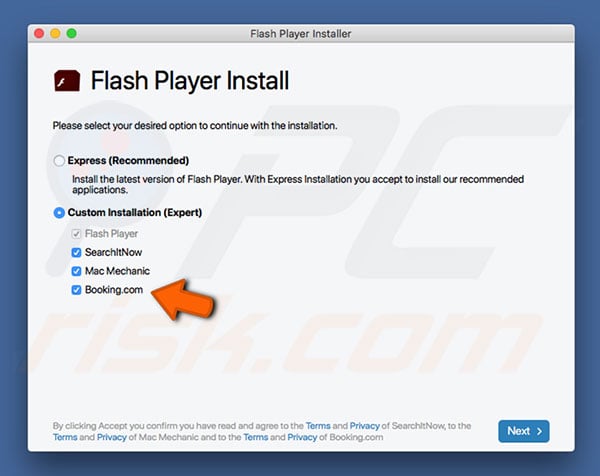
Examples of other deceptive installers designed to promote booking.com virus:
Screenshot of a deceptive installer promoting Microsoft Windows version of booking.com virus:
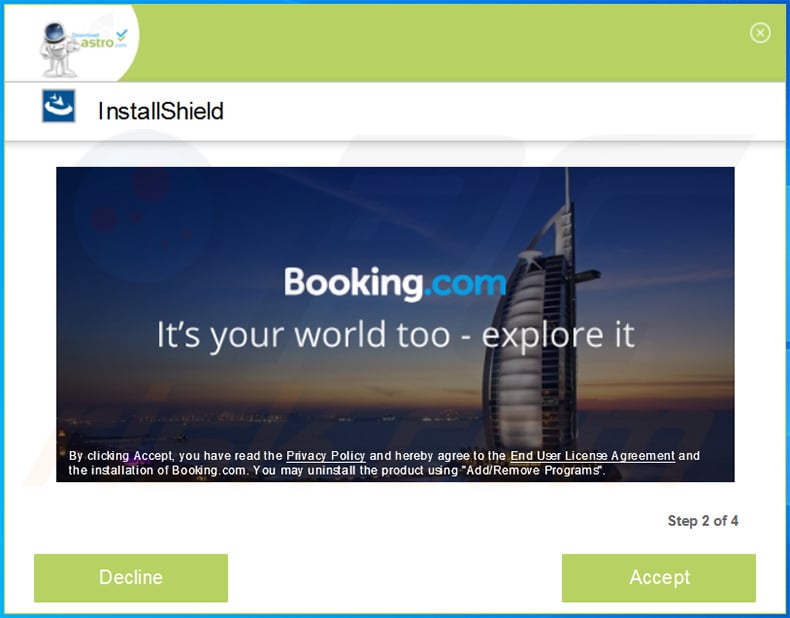
Instant automatic malware removal:
Manual threat removal might be a lengthy and complicated process that requires advanced IT skills. Combo Cleaner is a professional automatic malware removal tool that is recommended to get rid of malware. Download it by clicking the button below:
DOWNLOAD Combo CleanerBy downloading any software listed on this website you agree to our Privacy Policy and Terms of Use. To use full-featured product, you have to purchase a license for Combo Cleaner. 7 days free trial available. Combo Cleaner is owned and operated by RCS LT, the parent company of PCRisk.com.
Quick menu:
- What is booking.com?
- STEP 1. Remove PUA related files and folders from OSX.
- STEP 2. Remove rogue extensions from Safari.
- STEP 3. Remove rogue add-ons from Google Chrome.
- STEP 4. Remove potentially unwanted plug-ins from Mozilla Firefox.
Video showing how to remove adware and browser hijackers from a Mac computer:
Potentially unwanted applications removal:
Remove potentially unwanted applications from your "Applications" folder:

Click the Finder icon. In the Finder window, select “Applications”. In the applications folder, look for “MPlayerX”,“NicePlayer”, or other suspicious applications and drag them to the Trash. After removing the potentially unwanted application(s) that cause online ads, scan your Mac for any remaining unwanted components.
DOWNLOAD remover for malware infections
Combo Cleaner checks if your computer is infected with malware. To use full-featured product, you have to purchase a license for Combo Cleaner. 7 days free trial available. Combo Cleaner is owned and operated by RCS LT, the parent company of PCRisk.com.
Remove adware-related files and folders

Click the Finder icon, from the menu bar. Choose Go, and click Go to Folder...
 Check for adware generated files in the /Library/LaunchAgents/ folder:
Check for adware generated files in the /Library/LaunchAgents/ folder:

In the Go to Folder... bar, type: /Library/LaunchAgents/

In the "LaunchAgents" folder, look for any recently-added suspicious files and move them to the Trash. Examples of files generated by adware - "installmac.AppRemoval.plist", "myppes.download.plist", "mykotlerino.ltvbit.plist", "kuklorest.update.plist", etc. Adware commonly installs several files with the exact same string.
 Check for adware generated files in the ~/Library/Application Support/ folder:
Check for adware generated files in the ~/Library/Application Support/ folder:

In the Go to Folder... bar, type: ~/Library/Application Support/

In the "Application Support" folder, look for any recently-added suspicious folders. For example, "MplayerX" or "NicePlayer", and move these folders to the Trash.
 Check for adware generated files in the ~/Library/LaunchAgents/ folder:
Check for adware generated files in the ~/Library/LaunchAgents/ folder:

In the Go to Folder... bar, type: ~/Library/LaunchAgents/

In the "LaunchAgents" folder, look for any recently-added suspicious files and move them to the Trash. Examples of files generated by adware - "installmac.AppRemoval.plist", "myppes.download.plist", "mykotlerino.ltvbit.plist", "kuklorest.update.plist", etc. Adware commonly installs several files with the exact same string.
 Check for adware generated files in the /Library/LaunchDaemons/ folder:
Check for adware generated files in the /Library/LaunchDaemons/ folder:

In the "Go to Folder..." bar, type: /Library/LaunchDaemons/

In the "LaunchDaemons" folder, look for recently-added suspicious files. For example "com.aoudad.net-preferences.plist", "com.myppes.net-preferences.plist", "com.kuklorest.net-preferences.plist", "com.avickUpd.plist", etc., and move them to the Trash.
 Scan your Mac with Combo Cleaner:
Scan your Mac with Combo Cleaner:
If you have followed all the steps correctly, your Mac should be clean of infections. To ensure your system is not infected, run a scan with Combo Cleaner Antivirus. Download it HERE. After downloading the file, double click combocleaner.dmg installer. In the opened window, drag and drop the Combo Cleaner icon on top of the Applications icon. Now open your launchpad and click on the Combo Cleaner icon. Wait until Combo Cleaner updates its virus definition database and click the "Start Combo Scan" button.

Combo Cleaner will scan your Mac for malware infections. If the antivirus scan displays "no threats found" - this means that you can continue with the removal guide; otherwise, it's recommended to remove any found infections before continuing.

After removing files and folders generated by the adware, continue to remove rogue extensions from your Internet browsers.
Remove malicious extensions from Internet browsers
 Remove malicious Safari extensions:
Remove malicious Safari extensions:

Open the Safari browser, from the menu bar, select "Safari" and click "Preferences...".

In the preferences window, select "Extensions" and look for any recently-installed suspicious extensions. When located, click the "Uninstall" button next to it/them. Note that you can safely uninstall all extensions from your Safari browser - none are crucial for regular browser operation.
- If you continue to have problems with browser redirects and unwanted advertisements - Reset Safari.
 Remove malicious extensions from Google Chrome:
Remove malicious extensions from Google Chrome:

Click the Chrome menu icon ![]() (at the top right corner of Google Chrome), select "More Tools" and click "Extensions". Locate all recently-installed suspicious extensions, select these entries and click "Remove".
(at the top right corner of Google Chrome), select "More Tools" and click "Extensions". Locate all recently-installed suspicious extensions, select these entries and click "Remove".

- If you continue to have problems with browser redirects and unwanted advertisements - Reset Google Chrome.
 Remove malicious extensions from Mozilla Firefox:
Remove malicious extensions from Mozilla Firefox:

Click the Firefox menu ![]() (at the top right corner of the main window) and select "Add-ons and themes". Click "Extensions", in the opened window locate all recently-installed suspicious extensions, click on the three dots and then click "Remove".
(at the top right corner of the main window) and select "Add-ons and themes". Click "Extensions", in the opened window locate all recently-installed suspicious extensions, click on the three dots and then click "Remove".

- If you continue to have problems with browser redirects and unwanted advertisements - Reset Mozilla Firefox.
Share:

Tomas Meskauskas
Expert security researcher, professional malware analyst
I am passionate about computer security and technology. I have an experience of over 10 years working in various companies related to computer technical issue solving and Internet security. I have been working as an author and editor for pcrisk.com since 2010. Follow me on Twitter and LinkedIn to stay informed about the latest online security threats.
PCrisk security portal is brought by a company RCS LT.
Joined forces of security researchers help educate computer users about the latest online security threats. More information about the company RCS LT.
Our malware removal guides are free. However, if you want to support us you can send us a donation.
DonatePCrisk security portal is brought by a company RCS LT.
Joined forces of security researchers help educate computer users about the latest online security threats. More information about the company RCS LT.
Our malware removal guides are free. However, if you want to support us you can send us a donation.
Donate

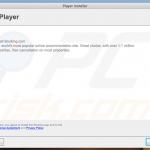
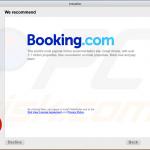
▼ Show Discussion